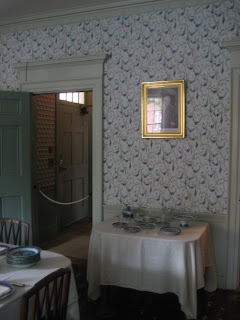Gardiner-Pingree House 1804 in Salem, Massachusetts
In August of 2009 I toured one of the finest Federal period homes in America. The Gardner-Pingree House in Salem, Massachusetts. Built by John Gardner and his wife Sarah in 1804 during Salem's most prosperous era, this elegant Federal red brick town house is widely admired in the published history of American architecture for its imposing but balanced and restrained brick facade. It remains the finest surviving example of the many Federal style houses built in Salem between 1793 and 1825. The house features a central hall plan, five-bay facade arrangement with central front door. The symmetry of the earlier Georgian style is retained. The lavish interior and exterior wood ornamentation were designed and carved by Salem's master builder and carver, Samuel McIntire, at the height of his powers. whose innate sense of proportion and attention to decorative detail make him one of the most celebrated architects of the early Republic.
The house showcases some of the most outstanding examples of McIntire's woodcarving, including the Corinthian capitals on the semicircular portico with semi-elliptical or semi-circular fanlight with flanking sidelights (which were original covered with 22 caret gold leaf) and the neoclassical ornaments on the mantels, doorframes, and Federal furniture of the magnificent double parlor. The Federal style was known for it's simplicity and lightness of detail. Much more refined than the heavier Georgian style.
The house was the site of the notorious 1830 murder of Capt. Joseph White, whose death prompted a famous trial prosecuted by Daniel Webster. The trial inspired Edgar Allan Poe and Nathaniel Hawthorne. The house is owned by the Peabody Essex Museum as part of the Essex Institute, and is open for guided tours. It features 18th and early 19th century furnishings. Today we are touring the formal dinning room & beautiful double parlors. The first set of photo's of the interior are of the formal dinning room. The first parlor is set up as a setting room with much of the furniture carved by Salem's golden boy Samuel McIntire. The back parlor is set up as a elegant breakfast room. Sorry my photo's are poor no flash photography allowed in the house
Corinthian capitals on the semicircular portico with semi-elliptical or semi-circular fanlight with flanking sidelights (which were original covered with 22 caret gold leaf)
Neoclassical Cast iron fence in the front of the home.
The dinning room
The first parlor is set up as a setting room with much of the furniture carved by Salem's golden boy Samuel McIntire.
Elegant Federal sofa carved by Samuel McIntire covered in black horse hair
Elegant Federal side chair carved by Samuel McIntire covered in black horse hair
Neoclassical door frame carved by Samuel McIntire
Detail of flower urn on Neoclassical door frame carved by Samuel McIntire
Neoclassical gilt and painted curtain cornice carved by Samuel McIntire
Neoclassical mantel carved by Samuel McIntire
Neoclassical opening between parlors carved by Samuel McIntire
Neoclassical opening between parlors carved by Samuel McIntire
Old Master painting of Cleopatra
The elegant breakfast room in the back parlor
elegant breakfast room











































It is all lovely and in keeping with its era. But the very nicest parts are the neo-classical mantel (which we expect in such a home) and neo-classical door frame (which comes as a very pleasant surprise. John and Sarah Gardner either had very good taste themselves, or they were well advised by their designers.
ReplyDeleteYou are right John and Sarah Gardner have very good taste and was lucky to have a genius Samuel McIntire to design, build and carve components of there home as well as decorate it and design and carve the furniture that went into the home. He was America's Adam brothers!
ReplyDeleteJohn and Sarah did get to enjoy their house for a few years.
ReplyDeletehttp://thomasgardnerofsalem.blogspot.com/2011/12/gardner-pingree-house-and-murder.html
Thank you to the Pingree family for preserving the house and donating it to the Essex Institute.